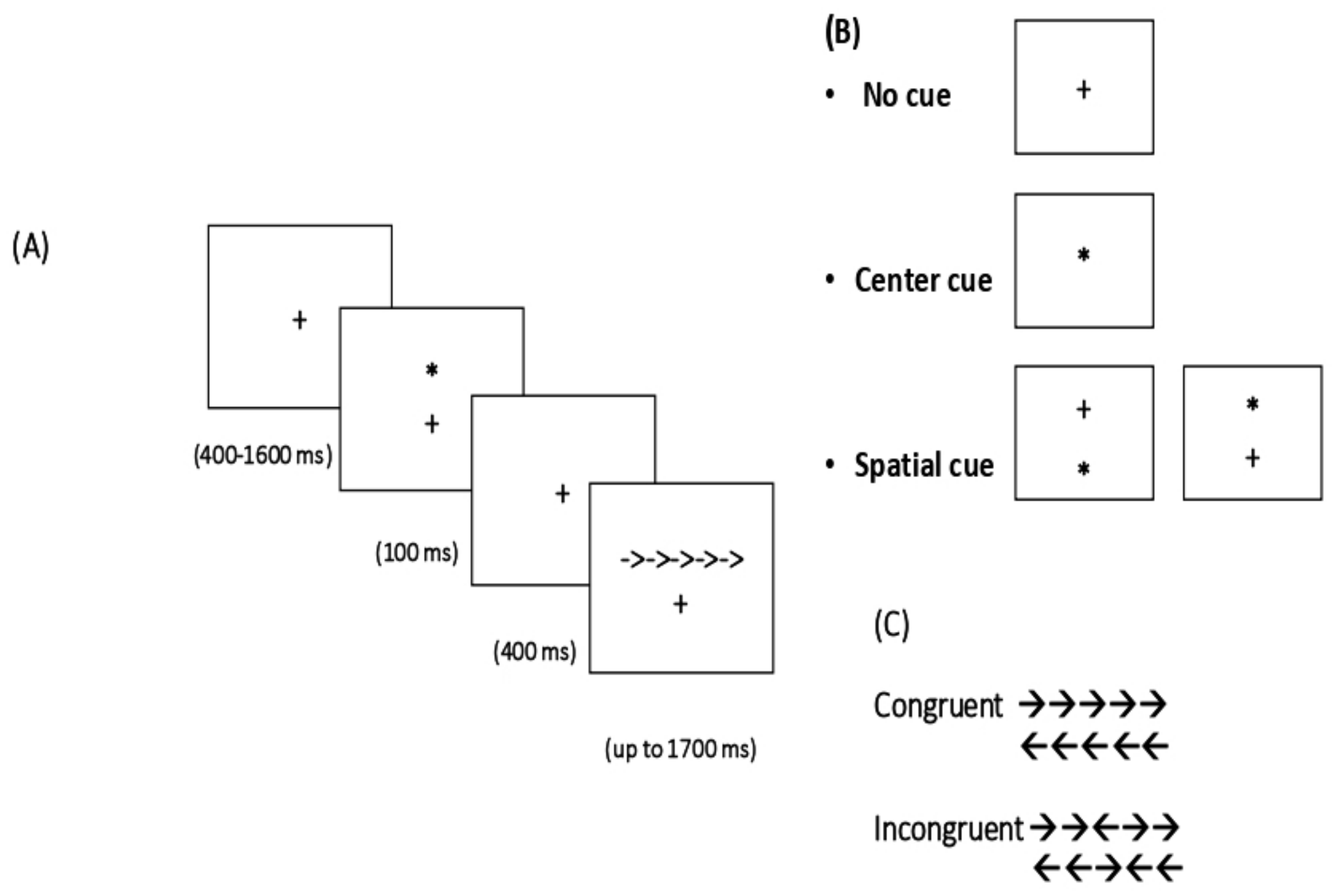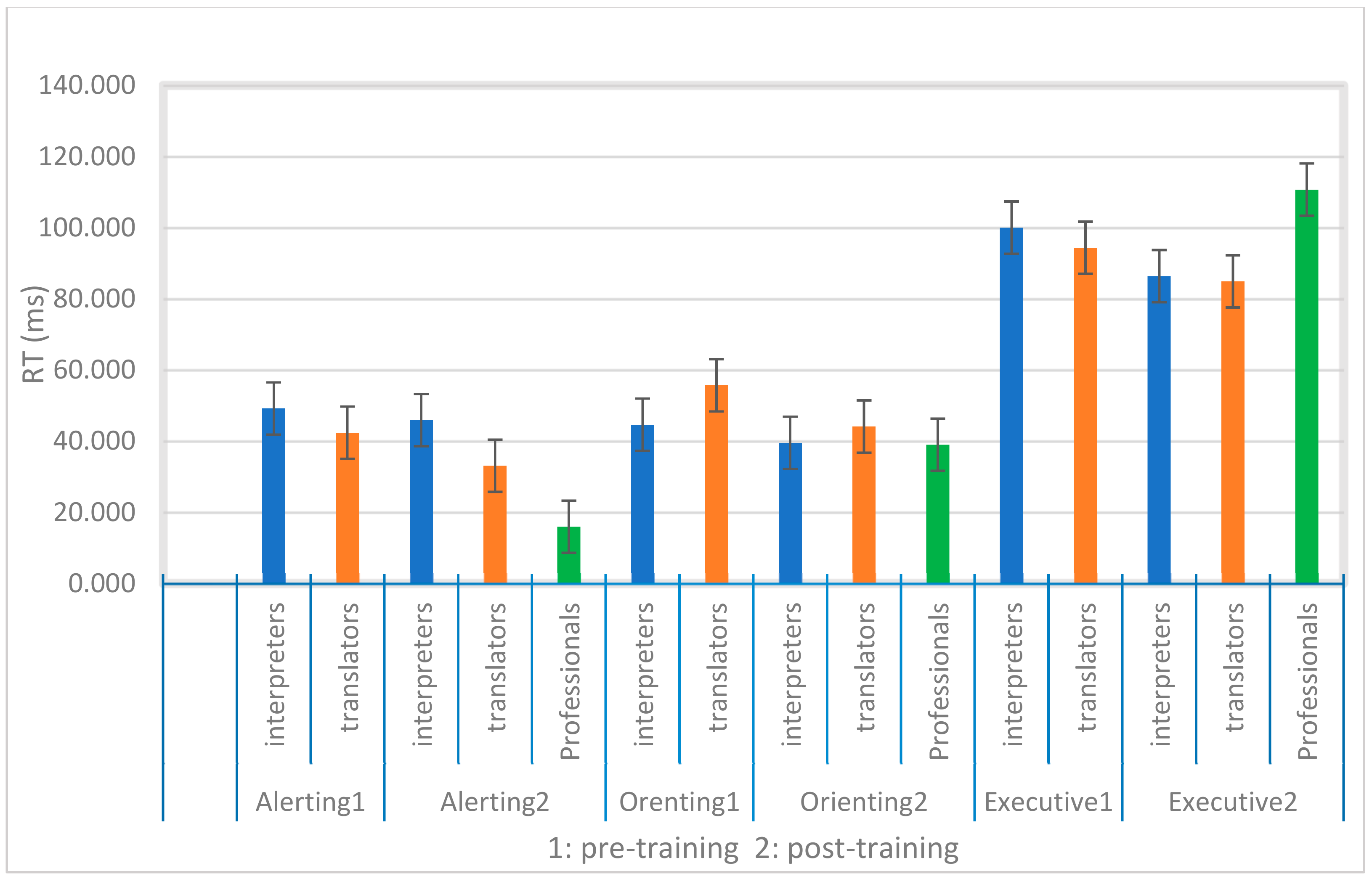Attention Network in Interpreters: The Role of Training and Experience
Abstract
:1. Introduction
2. Materials and Methods
2.1. Participants
2.2. The ANT Task
2.3. Procedure
3. Results
3.1. Data Analysis
- Alerting effect = (RT no cue–RT center cue)
- Orienting effect = (RT center cue–RT spatial cue)
- Executive control effect = (RT incongruent–RT congruent)
3.2. Interpreting Students vs. Translation Students
3.2.1. Conflict Effect
3.2.2. Alerting Effect
3.2.3. Orienting Effect
3.3. Student Groups and Professional Interpreters
4. Discussion
Author Contributions
Funding
Conflicts of Interest
References
- Petersen, S.; Posner, M. The attention system of the human brain: 20 years after. Annu. Rev. Neurosci. 2012, 21, 73–89. [Google Scholar] [CrossRef]
- Posner, M.; Petersen, S.E. The Attention System of the Human Brain. Annu. Rev. Neurosci. 1990, 13, 25–42. [Google Scholar] [CrossRef]
- Rueda, M.R.; Checa, P.; Cómbita, L.M. Enhanced efficiency of the executive attention network after training in preschool children: Immediate changes and effects after two months. Dev. Cogn. Neurosci. 2012, 2, S192–S204. [Google Scholar] [CrossRef]
- Pavese, A.; Posner, M.I.; Heidrich, A.; Moore Sohlberg, M.; McLaughlin, K.A. Evaluation of Attention Process Training and Brain Injury Education in Persons with Acquired Brain Injury. J. Clin. Exp. Neuropsychol. 2003, 22, 656–676. [Google Scholar] [CrossRef]
- Johnstone, A.; Marí-Beffa, P. The effects of martial arts training on attentional networks in typical adults. Front. Psychol. 2018, 9, 1–9. [Google Scholar] [CrossRef]
- Wang, B.; Guo, W.; Zhou, C. Selective enhancement of attentional networks in college table tennis athletes: A preliminary investigation. PeerJ 2016, 4, e2762. [Google Scholar] [CrossRef] [PubMed]
- Pérez, L.; Padilla, C.; Parmentier, F.B.R.; Andrés, P. The effects of chronic exercise on attentional networks. PLoS ONE 2014, 9, e101478. [Google Scholar] [CrossRef]
- Chan, D.; Woollacott, M. Effects of Level of Meditation Experience on Attentional Focus: Is the Efficiency of Executive or Orientation Networks Improved? J. Altern. Complement. Med. 2007, 13, 651–658. [Google Scholar] [CrossRef] [PubMed]
- Zhou, S.S.; Fan, J.; Lee, T.M.C.; Wang, C.Q.; Wang, K. Age-related differences in attentional networks of alerting and executive control in young, middle-aged, and older Chinese adults. Brain Cogn. 2011, 75, 205–210. [Google Scholar] [CrossRef] [PubMed]
- Jennings, J.M.; Dagenbach, D.; Engle, C.M.; Funke, L.J. Age-related changes and the attention network task: An examination of alerting, orienting, and executive function. Aging Neuropsychol. Cogn. 2007, 14, 353–369. [Google Scholar] [CrossRef]
- Dong, Y.; Liu, Y. Classes in translating and interpreting produce differential gains in switching and updating. Front. Psychol. 2016, 7. [Google Scholar] [CrossRef] [PubMed]
- Chmiel, A. Interpreting Studies and psycholinguistics: A possible synergy effect. Why Transl. Stud. Matters 2010, 223–236. [Google Scholar] [CrossRef]
- Macnamara, B.N.; Moore, A.B.; Kegl, J.; Conway, A.R. Domain-general cognitive abilities and simultaneous interpreting skill. Interpreting 2011, 13, 121–142. [Google Scholar] [CrossRef]
- Hervais-Adelman, A.; Moser-Mercer, B.; Michel, C.M.; Golestani, N. FMRI of simultaneous interpretation reveals the neural basis of extreme language control. Cereb. Cortex 2015, 25, 4727–4739. [Google Scholar] [CrossRef] [PubMed]
- Henrard, S.; Van Daele, A. Different bilingual experiences might modulate executive tasks advantages: Comparative analysis between monolinguals, translators, and interpreters. Front. Psychol. 2017, 8, 1–11. [Google Scholar] [CrossRef]
- Dong, Y.; Xie, Z. Contributions of second language proficiency and interpreting experience to cognitive control differences among young adult bilinguals. J. Cogn. Psychol. 2014, 26, 506–519. [Google Scholar] [CrossRef]
- Woumans, E.; Ceuleers, E.; Van Der Linden, L.; Szmalec, A.; Duyck, W. Verbal and nonverbal cognitive control in bilinguals and interpreters. J. Exp. Psychol. Learn. Mem. Cogn. 2015, 41, 1579–1586. [Google Scholar] [CrossRef]
- Morales, J.; Padilla, F.; Gómez-Ariza, C.J.; Bajo, M.T. Simultaneous interpretation selectively influences working memory and attentional networks. Acta Psychol. (Amst.) 2015, 155, 82–91. [Google Scholar] [CrossRef]
- Babcock, L.; Vallesi, A. Are simultaneous interpreters expert bilinguals, unique bilinguals, or both? Biling. Lang. Cogn. 2015, 1–15. [Google Scholar] [CrossRef]
- Babcock, L.; Capizzi, M.; Arbula, S.; Vallesi, A. Short-Term Memory Improvement After Simultaneous Interpretation Training. J. Cogn. Enhanc. 2017, 1, 254–267. [Google Scholar] [CrossRef]
- Roca, J.; Castro, C.; López-Ramón, M.F.; Lupiáñez, J. Measuring vigilance while assessing the functioning of the three attentional networks: The ANTI-Vigilance task. J. Neurosci. Methods 2011, 198, 312–324. [Google Scholar] [CrossRef]
- Kaushanskaya, M.; Blumenfeld, H.K.; Marian, V. Measures in Monolingual and Bilingual Speakers. Int. J. Biling. 2011, 15, 408–425. [Google Scholar] [CrossRef]
- Fan, J.; McCandliss, B.D.; Sommer, T.; Raz, A.; Posner, M.I. Testing the efficiency and independence of attentional networks. J. Cogn. Neurosci. 2002, 14, 340–347. [Google Scholar] [CrossRef] [PubMed]
- Eriksen, B.A.; Eriksen, C.W. Effects of noise letters upon the identification of a target letter in a nonsearch task. Percept. Psychophys. 1974, 16, 143–149. [Google Scholar] [CrossRef]
- Posner, M. Orienting of attention. Q. J. Exp. Psychol. 1980, 32, 3–25. [Google Scholar] [CrossRef]
- Hervais-Adelman, A.; Moser-Mercer, B.; Murray, M.M.; Golestani, N. Cortical thickness increases after simultaneous interpretation training. Neuropsychologia 2017, 98, 212–219. [Google Scholar] [CrossRef] [PubMed]
- Schneider, D.W. Alertness and cognitive control: Toward a spatial grouping hypothesis. Atten. Percept. Psychophys. 2018, 80, 913–928. [Google Scholar] [CrossRef]
- Weinbach, N.; Henik, A. The relationship between alertness and executive control. J. Exp. Psychol. Hum. Percept. Perform. 2012, 38, 1530–1540. [Google Scholar] [CrossRef]
- Wagenmakers, E.-J.; Imperati, D.; Derrfuss, J.; Tittgemeyer, M.; Brown, S.; Forstmann, B.U. The Speed-Accuracy Tradeoff in the Elderly Brain: A Structural Model-Based Approach. J. Neurosci. 2011, 31, 17242–17249. [Google Scholar] [CrossRef]
- Starns, J.J.; Ratcliff, R. NIH Public Access. Ind. Eng. Chem. Res. 2010, 25, 377–390. [Google Scholar] [CrossRef]
- Costa, A.; Hernández, M.; Sebastián-Gallés, N. Bilingualism aids conflict resolution: Evidence from the ANT task. Cognition 2008, 106, 59–86. [Google Scholar] [CrossRef] [PubMed]


| Translation Student | Interpreting Student | Professional Interpreter | ||||
|---|---|---|---|---|---|---|
| M | SD | M | SD | M | SD | |
| Age | 23.11 | 2.95 | 22.28 | 1.8 | 52.73 | 6.85 |
| AoA L2 | 6.78 | 4.45 | 5.44 | 4.21 | 8.03 | 4.1 |
| Recent exposure L1 | 50.26 | 18.83 | 47.12 | 14.51 | 40.85 | 17.36 |
| Recent exposure L2 | 22.53 | 12.73 | 16.71 | 10.33 | 19.21 | 17.19 |
| TRA/INT into L1 (self-rated proficiency) | 7.67 | 0.71 | 6.41 | 1.41 | 9.07 | 0.45 |
| TRA/INT experience (pre-test) | 0.00 | 0.00 | 0.00 | 0.00 | 24.60 | 12.15 |
| Congruent | Incongruent | |||||||
|---|---|---|---|---|---|---|---|---|
| T1 | T2 | T1 | T2 | |||||
| M | SD | M | SD | M | SD | M | SD | |
| RT | ||||||||
| INT | 537.96 | 68.56 | 507.29 | 75.07 | 636.69 | 64.27 | 593.66 | 70.63 |
| TRA | 539.58 | 56.24 | 529.25 | 74.73 | 632.62 | 58.47 | 614.15 | 68.52 |
| PRO | 640.88 | 46.94 | 751.55 | 54.03 | ||||
| ACC | ||||||||
| INT | 99.75 | 0.54 | 99.53 | 0.67 | 97.05 | 2.34 | 93.42 | 4.53 |
| TRA | 99.47 | 0.81 | 99.88 | 0.40 | 96.03 | 4.95 | 95.48 | 4.15 |
| PRO | 99.73 | 0.55 | 99.20 | 1.35 | ||||
| Alerting | Orienting | Executive | ||||||||||
|---|---|---|---|---|---|---|---|---|---|---|---|---|
| T1 | T2 | T1 | T2 | T1 | T2 | |||||||
| M | SD | M | SD | M | SD | M | SD | M | SD | M | SD | |
| RT | ||||||||||||
| INT | 49.15 | 36.1 | 45.90 | 25.7 | 44.56 | 36.03 | 39.52 | 23.6 | 100.01 | 34.2 | 86.37 | 25.8 |
| TRA | 42.36 | 37.5 | 33.06 | 35.4 | 55.68 | 27.9 | 44.09 | 33.8 | 94.35 | 34.8 | 84.90 | 26.5 |
| PRO | 15.94 | 29.9 | 38.97 | 32.27 | 110.67 | 22.4 | ||||||
| ACC | ||||||||||||
| INT | 0.00 | 0.38 | −0.27 | 0.46 | 0.00 | 0.37 | 0.07 | 0.26 | −1.87 | 1.8 | −4.4 | 3.1 |
| TRA | 0.25 | 37.5 | −0.08 | 0.29 | −0.25 | 0.75 | −0.25 | 0.75 | −2.1 | 3.6 | −3.16 | 2.8 |
| PRO | −0.09 | 0.44 | −0.05 | 0.22 | −0.38 | 1.1 | ||||||
© 2019 by the authors. Licensee MDPI, Basel, Switzerland. This article is an open access article distributed under the terms and conditions of the Creative Commons Attribution (CC BY) license (http://creativecommons.org/licenses/by/4.0/).
Share and Cite
Nour, S.; Struys, E.; Stengers, H. Attention Network in Interpreters: The Role of Training and Experience. Behav. Sci. 2019, 9, 43. https://doi.org/10.3390/bs9040043
Nour S, Struys E, Stengers H. Attention Network in Interpreters: The Role of Training and Experience. Behavioral Sciences. 2019; 9(4):43. https://doi.org/10.3390/bs9040043
Chicago/Turabian StyleNour, Soudabeh, Esli Struys, and Hélène Stengers. 2019. "Attention Network in Interpreters: The Role of Training and Experience" Behavioral Sciences 9, no. 4: 43. https://doi.org/10.3390/bs9040043
APA StyleNour, S., Struys, E., & Stengers, H. (2019). Attention Network in Interpreters: The Role of Training and Experience. Behavioral Sciences, 9(4), 43. https://doi.org/10.3390/bs9040043




